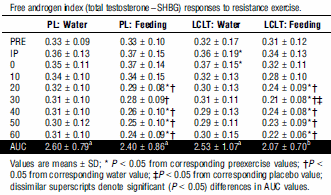|
Definition: "An ergogenic aid is any substance or phenomenon that enhances performance "
|
|
||||||||
10.09.2010 |
|
|
Carnitine plus a meal boosts post-workout testosterone uptake
L-Carnitine boosts the uptake in muscle tissue of testosterone or other androgens after intensive training. The effect is subtle, but according to sports scientists at the University of Connecticut, it may be big enough to achieve bigger gains in muscle power and mass from strength training.
In 2006 the researchers published the results of an experiment they carried out with 10 experienced male strength trainers. The men trained their most important muscle groups by doing squats, bench press, bent-over rows and shoulder press. They did 4 sets of 10 reps for each exercise.
The subjects trained in the mornings before breakfast.
On one occasion they drank water after their training session [Water], on the other they consumed a meal substitute, which provided 8 kcal per kg bodyweight. This contained 1.1 g carbohydrates, 0.3 g whole protein and 0.25 g fat [Feeding]. In fact, the test subjects were given Ensure Plus, produced by Abbott Nutrition.
Eating a meal after the training session also increased the number of androgen receptors, but the effect was stronger when the men took carnitine as well.
The increased activity of the androgen receptors as a result of the meal plus supplement led to a significant decrease in the amount of bioavailable testosterone, as you can see in the table below. In the lower table you will notice that the post-workout meal led to an increase in the production of LH after the training session. LH induces the testes to secrete testosterone. The effect was stronger when the men also took carnitine.
The researchers received money from carnitine manufacturer Lonza.
Carnitine has become a forgotten supplement, and unjustly so. This maybe because researchers didn't realise that carnitine needs carbohydrates to be able to enter muscle cells. Another reason is that the supplements industry has ruined carnitine's image. Half of the studies mention producers' sponsorship. And in far too many other studies, where there's no official mention of commercial money, the hand of industry is still visible. If you know where to look.
Source:
More:
|
|



